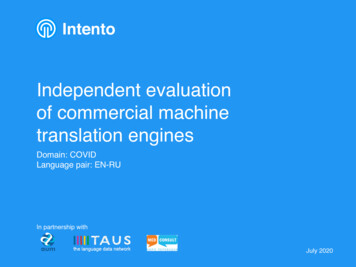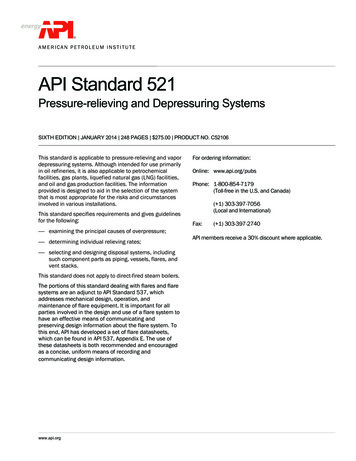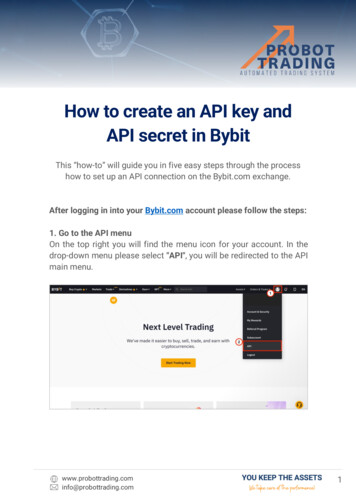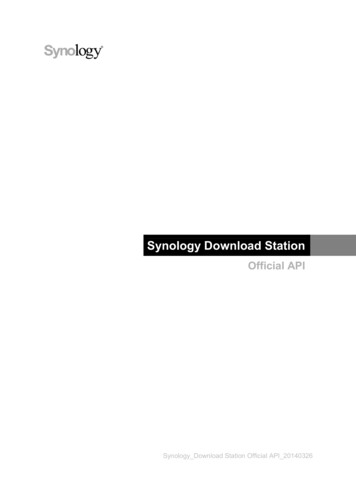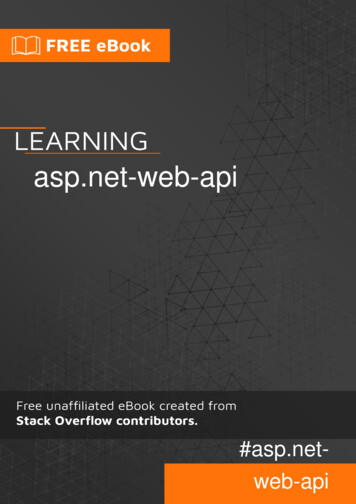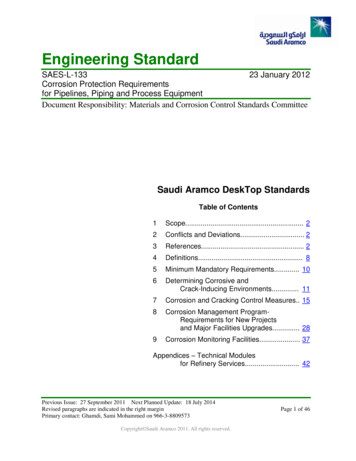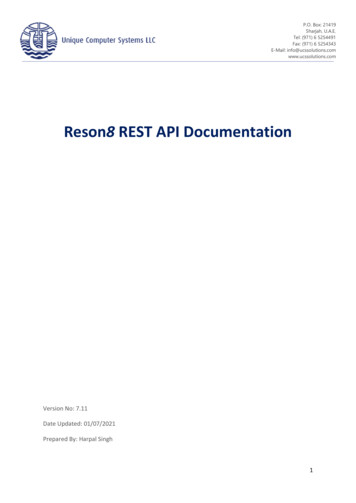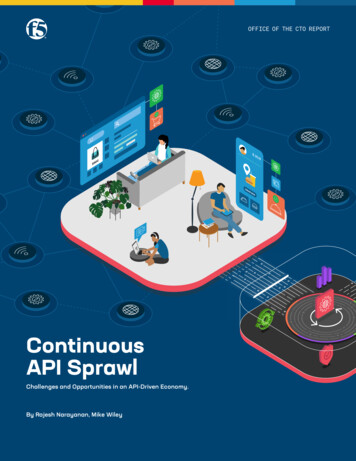
Transcription
OFFICEOFFICE OFOF THETHE CTOCTO REPORT 20.800 3ORDEContinuousAPI SprawlContinuousAPI SprawlChallenges and Opportunities in an API-Driven Economy.By Rajesh Narayanan, Mike WileyChallenges and Opportunities in an API-Driven Economy.By Rajesh Narayanan, Mike WileyRNOW
Table of Contents3Preface4 Introduction4Economic Impact5API Sprawl is Continuous and Growing5APIs come in Many Shapes and Sizes7Modeling API Growth7Parameters8Results10Contributing Factors to API Sprawl10Lack of Standards10Microservices Architecture10Continuous Software Development11Integration Challenges11Siloed Business Units12Hybrid Infrastructure13Edge Computing13Everything-as-a-Service14Why is This a Problem Today?14Operating at Scale15Security at Scale18Trust Decays18Secrets Sprawl19What Can We Do About It?19Intra-Cluster Discussion20API Sprawl is an Inter-Cluster Problem24Summary25ReferencesContinuous API Sprawl2
PrefaceThe Application Programming Interface (API) economy is the totality of all public and privateAPIs that exist globally at any given moment. It is continuously expanding and will soonAPI SPRAWL IS HOW WEDESCRIBE BOTH THEEXPONENTIALLY LARGENUMBER OF APIS BEINGCREATED, AS WELL ASTHE PHYSICAL SPREADOF THE DISTRIBUTEDINFRASTRUCTURELOCATIONS WHERE THEAPIS ARE DEPLOYED.reach a point where it will become a driving force in the global economy. Just as the oilindustry has dominated every aspect of our lives for over a century, APIs will become thecore driver of the economy.Prior to accelerated digital transformation, APIs were primarily viewed as a method ofintegration and a way to participate in a larger ecosystem. While, nearly half (43%) of businessestoday already leverage APIs as a source of revenue1 in addition to more traditional technicaluse cases, few have fully recognized the power of APIs to drive economic activity—althoughexamples like Twilio and Stripe portend future use of APIs as a powerful business tool.As we shift toward an API-driven economy, the problem we will need to contend with is theproliferation of API endpoints (a.k.a. API sprawl). Organizations that understand the cause ofAPI sprawl and put into place a strong infrastructure—with people, processes, and tools tooptimize their use of APIs—will thrive in this new API-driven economy.Figure 1: API-driven economyA RobustNeeds a RobustNeeds RobustNeeds a RobustAPI DRIVEN ECONOMYAPI INFRASTRUCTUREAPI MARKETSAPI INFRASTRUCTUREIf data is the new oil, then APIs will become the new plastic. Responsible creation, use,and management of APIs will be critical, else the sprawl will pollute and wreak havoc onthe ecosystem.The first step in building a strong API infrastructure is getting a handle on API sprawl.While intuitively we might consider this as a potential future issue, it is not recognized as asignificant business problem today—but it must be.SprawlScale(#APIs)Figure 2: Sprawl is a function of scaleand spreadSpread (#Locations)Continuous API Sprawl3
IntroductionAPIs are a contract between the service provider and service consumer. When any applicationuses an API, it needs to conform to an agreed-upon standard, with implicitly set expectations.What happens behind the scenes is of no concern to the consumer, enabling the serviceprovider to use whatever means necessary to deliver the value. The service provider maychoose any technology to deliver the service, and it may or may not optimize the resourcebeing utilized to deliver the service.E C O N O M I C I M PAC TBeginning from a simple software construct for two systems to communicate withoutinterdependency, APIs have evolved as a means for any entity connected to the internet totransact value through a well-defined contract.Initially, APIs were primarily used as a standard means for two applications to talk to eachother and exchange data. But APIs have evolved, and we are now seeing them used as ameans for a service to deliver value to a consumer of the API.APIs allow vendors to provide their goods and services in digital marketplaces. They haveenabled applications to disrupt the transportation, hotel, and restaurant industries throughride-shares (Uber, Lyft, etc.), home rentals (Airbnb, etc.), and delivery services (DoorDash, etc.).Apps such as YouTube, TikTok, Instagram, etc., have empowered the creative among us beappreciated and rewarded by gathering a large fan following. APIs allow us to safely transactwith anyone across the globe, securely, without needing to meet them in person. Internetof Things (IoT) devices, for example, prove their value by enabling their current state to beexchanged via an API.From fun apps to lucrative enterprise applications, API-powered apps have permeated everyaspect of our lives; and yet we are merely scratching the surface of the economic possibilities.To fully realize the economic and technical advantages of APIs we must first address asignificant obstacle: API sprawl.Continuous API Sprawl4
A P I S P R AW L I S C O N T I N U O U S A N D G R O W I N GAPI sprawl happens when APIs become widely distributed without a holistic strategy thatincludes governance and best practices. Exacerbating this problem of distribution is the factthat API sprawl is also continuous as development teams follow a continuous applicationlifecycle process. Applications and APIs are constantly changing over time—and each versionmay spread differently than a previous version.Scale(#APIs)Figure 3: Even a single API canchange and sprawl over timeSpread (#Locations)Figure 3 shows how a single API can be the source of multiple versions for different purposesand each of those versions can then have their own version history.It is important to recognize API sprawl as being continuous for a couple of reasons—(1) anymarket data estimate on the number of APIs is likely to be conservative, as the number ofAPIs will increase over time, and (2) any proposed solution must take into consideration thisaspect of continuous growth.APIS COME IN MANY SHAPES AND SIZES2There are different classes and types of APIs. The internet is full of API definitionsand classifications, but the one that aligns most closely with our own thoughts is thecomprehensive list provided by ProgrammableWeb.com.Continuous API Sprawl5
All APIs irrespective of type can be broadly classified as: Public—APIs available for anyone to use (e.g., Google Maps APIs). Private—APIs available only to internal teams or within an application cluster. Partner—APIs that integrate with a third-party vendor that can bring more value(e.g., an API that allows Netflix’s app to be installed on a Roku device).There are different types of APIs: Web—APIs that are accessible over the web. Product—APIs that are integrated into a product. When you buy the product anddeploy it, a version of that product’s APIs can be enabled. Browser—APIs in browsers that developers have access to and can recombine indifferent ways. Standard—APIs published by organizations or standards bodies for everyone tofollow. For example, browsers could have a standard set of APIs to get access to thecapabilities of the underlying system. Embedded—APIs that connect devices with proprietary data like IoT sensors.APIs can also be characterized based on scope: Single Purpose—APIs with one single function (e.g., storage with Dropbox). Aggregate—APIs that aggregate services from similar companies and offer them as asingle API (e.g., a storage aggregator may offer an API that aggregates storage acrossmultiple storage providers by orchestrating with their proprietary APIs). Microservices—APIs that are typically within the scope of a microservices architecture.These APIs combine different microservices within an organization using somebusiness logic, package them, and then expose them through a single API.Figure 4 visualizes how APIs have developed over time from very few in monolithicsystems to today where there are exponentially more APIs due to the proliferation ofmicroservices architectures.Figure 4: Visualizing API sprawl2010Continuous API Sprawl201520216
Modeling API growthBased on our estimation the number of APIs worldwide (public or private) is alreadyapproaching 200 million.PA R A M E T E R SQuantifying API growth is not straightforward as there are several parameters that it depends on. Number of developers worldwide Number of developers writing APIs Number of APIs per developers per year Avg. growth in total # of developers Avg. growth in # of developers writing APIs Avg. growth in # APIs per dev per year Avg. shelf life of each APIBased on the above parameters we can reasonably derive a model to estimate API growthover a 10-year period. The table (Figure 5) shows the assumptions made in the data model tocreate the baseline. The blue line in the graphs below represents the baseline.Figure 5: API sprawl baseline modelparameters1#Devs worldwide in 201823.92%Devs writing APIs30%3Avg. #APIs per dev per year9.44Avg. worldwide growth rate of devsNA5Avg. worldwide API dev growth rate15%6Avg. growth in #APIs per dev per year15%7Avg. shelf life of APIs in years1The API growth model assumes a 2018 start point of number of developers as 23.9 million.We were able to find references to number of developers from different sources (startingin 2018). To be fair, different sources may have numbers off by a wide margin; for example,SlashData estimates this number to be about 24M as of April 2021.3Figure 6: Developer growth dataYear# Devs 202327.7cont.Continuous API Sprawl7
Year# Devs 202942.3203045For our model we have used 23.9 million in 2018. But as we shall understand later, thisstarting number doesn’t matter much.The table (Figure 6) shows the number of developers worldwide. The rows in black have anexternal reference, while the ones in red are estimated based on where we expect to be in 2030.R E S U LT SFigure 7 shows estimated API growth over a 10-year period. The model represents bothvery conservative (in purple) and aggressive (in light blue) growth. Irrespective of where thenumbers land, we are witnessing a phenomenal growth in the number of APIs, resulting inpotentially more than one billion APIs by 2031.12001000800Millions600400Baseline # Mil. APIs / yrConservative # Mil. APIs / yr200Aggresive # Mil. APIs / yrFigure 7: 10-Year estimated APIgrowth201820202022202420262028203010 Year API Growth (Estimated)The 10-year growth estimate can be justified by the following analysis of the model.API growth as a function of API shelf life: The 10-year estimated growth chart assumes aone-year shelf life. Figure 8 shows the API growth as a function of shelf life.In this graph we estimate the number of active APIs in any given year. The graph cumulatesthe previous two and three years to estimate the number of active APIs at any given pointin time, based on a two-year or three-year shelf life. According to this model, we will beapproaching 1.7 billion active APIs by 2030.Continuous API Sprawl8
180016001400Millions12001000800600API Expiry # Mil APIs—1 yr400API Expiry # Mil APIs—2 yr200Figure 8: API growth as a function ofAPI shelf lifeAPI Expiry # Mil APIs—3 yr2018202020222024202620282030#Mil APIs as a function of API Shelf-life(API expiry in yrs, i.e. #yrs API versions are supported)API growth as a function of the number of API developers: Another parameter affecting APIgrowth is the number of developers. We see that the number of developers is growing overtime and start with a baseline of 23.9 million developers in 2018.We calculate API growth based on the number of developers who are developing APIs as30%, 60%, and 90% of the worldwide developer pool. Figure 9 shows the growth of APIs as afunction of increased developer pool.250020001500Millions1000%of API Devs “30%”500%of API Devs “60%”%of API Devs “90%”Figure 9: API growth as a function ofworldwide developers2018202020222024202620282030#Mil APIs /yr as a function of Total #API Developers(#API Devs 20/60/90 % of total worldwide Devs)Based on this model, we will be approaching 2 billion APIs by 2030 with just a one-year shelf life.Summarizing the API growth model, we can say that it truly does not matter what our startingpoint is. Whether we assume 24 million developers in 2018 or 2021, the number of APIs by2030 will be in the 100s of millions, making it a significant scalability, manageability, andsecurity challenge for our customers and the industry. It does not matter what parameters ofthe model we tweak; API sprawl will be a global problem. Discovery, networking, integration,and security are set to become significant challenges for the entire Dev and Ops ecosystem.Continuous API Sprawl9
Contributing Factors to API Sprawl4All business units deploy services through some application platform, and regardless ofwhether the application is monolithic or microservices-based, APIs are becoming the standardmeans to interact with these services.L A C K O F S TA N D A R D SWhile there are data-formatting standards, such as the use of JSON and XML to encapsulatethe data exchanged by APIs, there are few global standards for APIs themselves.Interestingly, the few emerging API standards that exist tend to focus on business domains.For example, FDX is an organization “dedicated to unifying the financial services ecosystemaround a common, interoperable, and royalty-free technical standard aptly named the FDXApplication Programming Interface (FDX API).”5 Its membership includes nearly every financialorganization, making it a powerful force for establishing a standard.Within the technology domain, however, APIs have followed their natural predecessors, theCommand Line Interface (CLI). No two are the same. For example, different Infrastructure as aService (IaaS) providers can represent a set of server resources as Server Pool or Server Farm.The two APIs might be doing the same thing, resulting in significant overlaps in the industry.APIs may be reflective of an application’s internal data model and not follow an established orformal standard. The lack of a common shared model contributes to API sprawl.MICROSERVICES ARCHITECTUREAs businesses go through digital transformation, they are increasingly adopting cloud-basedmicroservices architectures. The move to microservices results in an application beingcomposed of many dozens of APIs. In addition, organizations tend to create an access layerto legacy systems via APIs.Microserices are accretive and often used to extend “traditional” apps to hidden interfacesvia APIs. This is actually a considerable source of API sprawl, because the APIs are bothnorthbound to interfaces via microservices and horizontally between microservices.C O N T I N U O U S S O F T WA R E D E V E L O P M E N TAdding to this issue is the state of modern software development, which is itself continuousand often results in multiple versions of the same API as mentioned earlier.As enterprises increasingly adopt the continuous software lifecycle, developers can churn outmany APIs, and many versions of an API, over a short period of time. This can make the APIContinuous API Sprawl10
versions hard to track. In addition, documentation suffers if developers are not meticulous intheir practice. Thus, continually modifying, updating, and changing APIs amplifies the sprawl(e.g., enterprises may have different versions of the same API available in different regions).The agile development process enables teams working on short sprint cycles to develop newAPIs and enhance existing ones rapidly. Keeping track of different versions of an API that hasbeen deprecated, deployed, or deleted can become a daunting task to manage. Enterprisesmay need to maintain deprecated APIs over a longer term due to existing customer supportissues. If there are changes to the development team or the operations team, these may turninto zombie APIs running somewhere in the infrastructure but not managed by any given team.The resulting state of APIs, with multiple versions due to both continuous development and alack of standards, poses a significant challenge to integration efforts.I N T E G R AT I O N C H A L L E N G E SIntegration is a main focus for developers today and hence a significant factor in API growth.App modernization efforts drive 58% of organizations to add APIs as ways to connect modernuser experiences with existing, traditional applications.6 According to the Postman blog,7 70%of enterprises cited integration between internal applications, programs, or systems as themain reason to create new APIs.Many companies have internal initiatives to create seamless integration between theirsoftware assets. Such integration efforts are complex orchestrations of technical andorganizational challenges. In any enterprise, most of these assets either develop organicallyor come in through mergers and acquisitions.But more than acting just as application “glue,” APIs are now treated as “business glue”because they enable participation in economic and service ecosystems to strengthenstrategic partnerships. 83% of organizations today consider API integration a critical part oftheir business strategy.8The use of APIs creates a well-defined interface between two apps to integrate and enablesthe organization to preserve the autonomy of different product teams serving internal andexternal customers. Care must be taken to avoid the duplication and confusion that can comefrom distinct business and product units operating autonomously and integrating with APIs.SILOED BUSINESSES UNITSOrganizational business units are siloed by design. Different product and dev teams alsobecome siloed depending on the best practices they adopt. Integrating the services createdby these business units can be a daunting challenge.Continuous API Sprawl11
Within a well-established business unit, the enterprise may have multiple product teamsdeveloping separate microservices and products for an uber-project. In addition, mergers andacquisitions introduce new silos, new architectures, and new APIs. Teams can end up reinventingAPIs for the same service repeatedly, which can result in integration challenges later. Teams willjostle and struggle with questions like, “Which API from which team is better?” The discussion canquickly descend into organizational politics and not-invented-here9 syndrome.HYBRID INFRASTRUCTUREAn outcome of siloed business units is that every team tends to adopt an infrastructurestrategy (Figure 10) they are comfortable with, based on familiarity and skill sets. On-premteams spar over OpenStack vs. VMware and other home-grown technologies as they moveto the cloud it becomes GCP vs. AWS vs. Azure vs. whatever they are most acquainted with.APIs thus get dispersed over many locations and become difficult to track.Architectural Proliferation48%Complexity rises as an increasing number of organizationsoperate multiple application gure 10: Organizations operatingmultiple earchitecturesFourarchitecturesFivearchitecturesAs the definition of multi-cloud expands (Figure 11) to include emerging edge computingplatforms and environments, API sprawl will continue to expand as well.Continuous API Sprawl12
Cloud deployments are nearly as common as on-premises deployments.72%On Premises68%Cloud28%Co-location27%Managed serviceFigure 11: Cloud deployments asopposed to othersEdge15%EDGE COMPUTINGAs the cloud expands to wherever the assets become available, and closer to where the datais generated, edge computing becomes part of a distributed cloud.API mobility: APIs have become the primary means to interact with different data sources.APIs are also moving closer to the data to collect, collate, and pre-process it. If the datasource moves, as in the case of a mobile or IoT device, the related API also becomes mobile.An API could move to a new destination that may be outside the geo-fenced location withconstraints. Different versions of an API might be needed depending on the type of enterpriseaccessing it, physical location, security needs, or compliance with regulatory environments.Data sprawl: Data sprawl contributes to API sprawl because data by its nature is dispersed.As APIs become the gateway to data, an outcome of edge computing is that APIs getdistributed to where the data is located, which adds to the sprawl. App developers use APIsto gather that data and create further value—but also further complexity.EVERYTHING-AS-A-SERVICEThe next evolution from Software as a Service is Everything as a Service (XaaS), whereanything tangible can now be consumed in an as-a-service model. With software, anythingtangible is modeled as a “digital twin.”11 The scheduling and delivery of these things is throughan API. Companies like Airbnb, Uber, DoorDash, etc. are all examples of XaaS.As the number of XaaS offerings increases, we are back to the need for standards, or somecommon way to represent these APIs. But unification of these APIs under some largerumbrella is impractical. We are left with a significant challenge, but also an opportunity.Continuous API Sprawl13
Why is this a problem today?In a digital world built on the API economy, those APIs must be 100% reliable. One must beable to access them anytime from any location, device, or entity.From the Postman blog,12 enterprises list the top four reasons when choosing an API asreliability, security, performance, and documentation, in that order.API Academy13 outlines several factors contributing to reliability: consistency, availability, lowlatency, security, and status reporting. The question is “How can one reliably track reliabilitywhen the APIs are sprawled across a heterogeneous and distributed cloud?”There are several factors affecting the reliability of APIs that are exacerbated due to theimmense scale and spread created by API sprawl.O P E R AT I N G AT S C A L EIn a constrained environment (e.g., within a cluster), it is easier to discover, connect, secure, andestablish trust through centralized management and control. Sprawl forces us to adjust the waywe think—from a purely hierarchical model to a distributed and autonomously scaling model.No source of truthAs the number of APIs and the complexity of the apps grow with the organization, it becomesvery hard to track where these apps are located. All the APIs may not be registered ordiscoverable as they might be behind different infrastructures.Whatever the real numbers are, the problem is massive. APIs have a shelf life and becomeunsupported if ignored by the developers. We will need an inventory of deprecated orunsupported APIs—something like an “API garbage collector.”Within the decade we will see services mushroom, which will validate public or private APIsfor the latest versions, supportability, security etc., and offer it as a SaaS platform: a sourceof API truth.API discovery challengesAnother significant challenge enterprises are already facing is discovering APIs within andoutside the enterprise. Existing approaches only tend to cover within an application cluster(e.g., API gateways within a service mesh). But even within a single enterprise there could behundreds of clusters using different service mesh technologies.Continuous API Sprawl14
INTRAClusterFigure 12: Intra-cluster vs. interclusterINTERClusteruServiceCluster AuServiceCluster BAPIs are not just intra-cluster, but also inter-cluster (Figure 12).Versioning and documentationThe problem with versioning is primarily when APIs change rapidly due to updates, beingdeprecated, or not supporting certain protocols. The expectation is that the remote servicecalling this API also needs to change. When the microservices are being designed by thesame team for the same application, this may work, but the complexity rapidly increases if theAPIs are being published as third party or being consumed from a third party.APIs also have a lifetime and may become unsupported or unavailable over time. If an APIfails, the backup must be implemented by the developer who must also make changes totheir application to handle responses.Connectivity challengesApproaches like service mesh assume that robust and reliable network connectivity alreadyexists. Within an enterprise this may be true to an extent. For a finite number of high-priorityprojects the network infrastructure and security team can become closely involved in networkplanning, configuration, and security to ensure reliable end-to-end connectivity is available.In many cases when the APIs are across clusters (public or private), a simple means toconnect these APIs may not be available with conventional or legacy networking approaches.S E C U R I T Y AT S C A L EMore than nine out of ten of enterprises experienced an API security incident in 2020.14Every API thus becomes a point on the security perimeter that can be potentiallycompromised if not properly architected or protected.To reiterate, the term “sprawl” is an indication of both numbers in terms of scale and beingphysically dispersed over a wide area. At such scale, security cannot be implemented as anadd on feature. It must become part of the entire API lifecycle, from code to deployment toend-of-life.Continuous API Sprawl15
APIAPPWebhookSERVICEAPPSERVICEAre we there yet?Are we there yet?Are we there yet?Are we there yet?Are we there yet?Figure 13: APIs and webhooksYes, we have arrivedWe have arrivedSynchronousAsynchronousFigure 13 shows the difference between APIs and webhooks (addressed below).APIs prone to fraud and malicious behaviorsIf enterprises are not careful when using APIs, there are many opportunities for fraud andmalicious behavior to creep into an implementation. Product and dev teams may be on adeadline looking to incorporate a certain feature provided by an external API. If due diligenceis not performed on the API provider, it could result in basic security issues and sophisticatedattacks, such as tainted data meant to undermine a business.Assume we have two competing enterprises: RED and BLUE. Both are a type of retail or brickand-mortar store. Now BLUE has implemented an app showing the nearest location of itsdifferent stores. The map service used by BLUE is provided by PURPLE via an API.PURPLEBLUESERVICEHackerCompromisesPurpleAPIAre we there yet?Take detourAre we there yet?Slight detourAre we there yet?Yes, we have arrivedFigure 14: API fraud exampleSynchronousFigure 14 is an example of how a malicious actor does not need to hijack the client (BLUE)to cause long-term problems for the client. RED acquires or invests in PURPLE and insertsContinuous API Sprawl16
randomness or inaccuracies into the API only when BLUE accesses it. A more complex andlong-term scenario is that state actors or a hacker group hijacks PURPLE’s APIs to affectBLUE’s performance and eventually affects BLUE’s stock; this could take much longer todetect or might even go completely undetected.Webhooks can be weaponizedWebhooks15 are basically user-defined HTTP callbacks or small code snippets linked to a webapplication. These callbacks are triggered by specific events in a remote site which use thesecallbacks. For example, if the BLUE service has registered a webhook with PURPLE service, itis indicating to the PURPLE service to call it when there is a specific triggering event.Unlike APIs, webhooks are asynchronous. Any application needing an event notificationfrom another software program can register a URL. Most security teams seem to rely on theanonymity of a webhook URL to maintain its security.Figure 15: Webhooks fraud examplePURPLEBLUESERVICEHackerAcquiresPurpleWHTake expensivetoll roadTraffic aheadconsider detourYou have arrivedAsynchronousWebhooks are potentially more dangerous (Figure 15) as a malicious actor can directly call BLUEif they can compromise PURPLE. There is no need to wait for BLUE to initiate the request.Once a webhook URL is exposed and its data-model revealed, any hacker can hack into aservice and send a malformed data-object asynchronously. A Dark Reading article16 exposedhow Slack’s webhooks could be weaponized by creating phishing attacks on a Slack channelthat was compromised due to an exposed webhook. “Graves said a quick scan of GitHub hadthrown up more than 130,000 public code results that contained Slack webhook URLs, mostof them containing the full unique value.”A hacker can easily scan all the GitHub repos for public Slack webhook URLs and automatethe entire process of sending out malformed messages with phishing links.Continuous API Sprawl17
T R U S T D E C AY SAPI security is a complex subject and “trust” makes up an important component.When a service within the enterprise accesses a well-known external API, the platform mustimplement a mechanism by which the calling service can be assured of the accuracy of thereceived response from the external API. Just because the API response looks valid, andcomes from a previously validated endpoint, does not mean it can be trusted (Figure 16).Proof of Identity Proof of Work Proof of TrustFigure 16: Proof of trust iscomplicatedEither the response could be inaccurate due to quality issues, or as we learned earlier,inaccuracies can be explicitly inserted to make the business less competitive. Like the agileprocess, trust is continuous and must be constantly validated.S E C R E T S S P R AW LSecrets17 are anything allowing privileged access into a system. There are many types ofsecrets in computer systems: username/password combinations, client ID/secret, certificates,tokens, keys, and database credentials.The most common method for APIs to authenticate are through API keys. Customers canhave API tokens distributed randomly in unsecure locations. The API keys could be stored inclear-text within a database or source code (git-repos), available in an office email or personalemail, or found in a backup drive or Google drive.This is where the API
Continuous API Sprawl 6 All APIs irrespective of type can be broadly classified as: Public—APIs available for anyone to use (e.g., Google Maps APIs). Private—APIs available only to internal teams or within an application cluster. Partner—APIs that integrate with a third-party vendor that can bring more value (e.g., an API that allows Netflix's app to be installed on a Roku .

